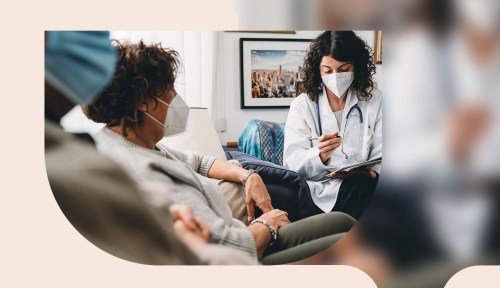Being admitted to the hospital is an inherently stressful experience—you’re concerned about your health, worried about a procedure, and feeling isolated from friends and family outside of visiting hours. That hospital visit would become all the more difficult if no one communicated with you throughout your stay to explain complications that arise or change in prognosis, or if you were not able to ask for help whenever you were in discomfort.
Experts in This Article
Felicia Barbosa is a professional medical interpreter.
Maria Vertkin is the founder and executive director of Found in Translation, a non-profit aimed at providing free medical interpretation training to low-income women in the Greater Boston area.
For immigrants to the United States who speak a language other than English and have limited English proficiency—that is, 50 percent of the total immigrant population in the U.S.—the above-mentioned situation happens far too often. Though federal and state laws require that professional interpretation services be provided at any health-care organization that receives Medicaid or Medicare funding, research shows that over 30 percent of hospitals do not provide adequate translation services. (There are a variety of reasons for this, including the reality that hospitals must provide interpretation free of charge to patients—services that aren’t always covered by insurance.)
In some cases, facilities without professional medical interpreters—whose job is to translate doctors’ and nurses’ orders and diagnoses and help patients understand their rights and options—might try to accommodate a patient by asking a family member or bilingual staff member to interpret for the patient, but this increases the risk for errors and violates confidentiality. Or worse, health providers may skip trying to bridge the language divide altogether, says Maria Vertkin, founder and executive director of Found in Translation, a nonprofit that empowers low-income bilingual women to launch careers as professional medical interpreters. “When people who aren’t immigrants themselves meet someone who doesn’t speak English, they [often] tend to perceive that person as a nonverbal being,” says Vertkin, whose family immigrated from Israel and the former USSR to the United States when she was a young child.
When adequate interpretation is not provided, Vertkin says important information like informed consent and medical history aren’t collected to advise a patient’s care and diagnosis. As a result, patients with limited English proficiency are more likely to experience infections and other complications, physical harm, longer stays, and re-admissions due to difficulty understanding instructions or how to manage their conditions. With immigrant health already disproportionately impacted by social determinants of health such as trauma, poorer living conditions, and higher unemployment rates, it is startling that professionally trained medical interpreters are not always utilized to give this population their voice.
Finding new beginnings in interpretation
This is where Vertkin’s organization comes in. She started Found in Translation back in September 2011 with two aims in mind: to reduce health disparities by training more bilingual interpreters and to provide lucrative employment opportunities for lower-income immigrant women—who are less likely to be employed than native-born women in the U.S. and have a lower average income than native-born U.S. women.
Having previously worked with immigrant women in her career as a social worker, Vertkin sought to utilize their bilingual ability to help them find their footing. Her initial efforts to match her clients with existing medical interpreter training courses were largely unsuccessful—which she says was often due to discrimination and preconceived negative stereotypes about low-income women.
“Seeing people be able to communicate their needs, and seeing their satisfaction of being able to have done an appointment, it’s gratifying.” Felicia Barbosa, medical interpreter
Her solution was Found in Translation, which offers free medical interpretation training to 35 to 40 lower-income women in the Greater Boston area each year. (Pre-COVID, this training was offered via in-person classes at various locations in Boston; Found In Translation shifted to provide purely online training due to the pandemic.) Applicants must meet a series of criteria—such as bilingual ability, residence in the Boston area, and income level—and go through an interview process with the Found in Translation team before being admitted to the program. In just over a hundred hours, the women are trained in interpreter skills and ethics, medical terminology, and human physiology—training that typically costs hundreds of dollars to complete through other programs. Participants are also coached on how to navigate the workforce and manage their wages to achieve their financial goals, and are provided job placement support after they complete their training.
Felicia Barbosa, a medical interpreter and graduate of the course, was juggling two jobs when she applied in 2019. “The Dunkin Donuts I worked at opened at 4 a.m. so I had to wake up between 2:15 a.m. to 2:30 a.m., work until 12 p.m., then go to my other job at an insurance agency. On some days I’d just work 9 a.m. to 5 p.m. at the insurance agency. At the end of the week, it would be just enough to pay the bills [but] there wouldn’t be any money left over.”
Her career as a medical interpreter not only pays well—Found in Translation says the average salary of its graduates is $25 per hour after one year—but is fulfilling. “Seeing people be able to communicate their needs, and seeing their satisfaction of being able to have done an appointment, it’s gratifying,” Barbosa says.
The ongoing challenges in the medical interpretation space
Increasing the number of medical interpreters in the field is one hurdle to achieve improved health-care access for non-English speakers. But Vertkin says the next is ensuring that doctors and hospitals know how to utilize these trained professionals effectively (and use them in the first place).
Part of the problem, she says, is that not all health-care providers (including doctors and nurses) get any training around using professional interpreters. Although a 2017 survey showed that 76 percent of medical schools provide training for how to work with interpreters, this result was extrapolated from the 26 percent of schools that responded. “Found in Translation does some training for medical students, and [the students] are always surprised to hear that it’s a legally protected right and you have to have a trained interpreter,” says Vertkin. Even during her social work training, the social work graduates—who would often go on to work with immigrants—were taught to communicate across a language difference by just being empathetic and respectful, not by invoking the help of a trained interpreter.
“Between not knowing that they’re entitled to an interpreter and knowing how to ask for one, people who don’t speak English in the U.S. are often made to feel unwelcome.” —Maria Vertkin, founder of Found in Translation
Patients also have misconceptions about medical interpretation that keep them from utilizing these services. Barbosa observes that within the Brazilian community for which she provides Portuguese interpretation, there is an assumption that interpreters are too expensive. “When my dad immigrated here 35 years ago, you used to have to pay interpreters. People took advantage of the situation and now there are still interpreters working for themselves who overcharge,” says Barbosa.
Now that the cost is often footed by health-care providers, not patients, there remains a lack of awareness that patients in need could get an interpreter at the doctor’s office at no cost to themselves if they asked. “Between not knowing that they’re entitled to an interpreter and knowing how to ask for one, people who don’t speak English in the U.S. are often afraid and made to feel unwelcome,” Vertkin says. “They do not want to draw attention to themselves or be difficult.”
The ongoing coronavirus pandemic, which has pushed Found in Translation to move its interpretation services online, has further complicated the landscape. “Technology, in general, is almost like learning a new language itself,” Barbosa says. “And some [patient] families don’t have the technology or they don’t have the understanding of how to use these online platforms to be able to do telehealth.” Although Barbosa and her colleagues do their best to coach clients through setting up online consultations, she recognizes that they need to persist in finding ways to improve language interpretation accessibility in an increasingly digital and physically distant age—especially during a public health crisis like the pandemic that disproportionately affects immigrants.
Vertkin puts it this way: “Without being able to speak to your provider, a visit to the doctor is more like a visit to a vet. That is no way to treat people because we do have a way to communicate with people who speak all kinds of languages.” Hopefully, the 256 (and counting) alumnae of Found in Translation can start to change that narrative, one word at a time.
Oh hi! You look like someone who loves free workouts, discounts for cult-fave wellness brands, and exclusive Well+Good content. Sign up for Well+, our online community of wellness insiders, and unlock your rewards instantly.
Sign Up for Our Daily Newsletter
Get all the latest in wellness, trends, food, fitness, beauty, and more delivered right to your inbox.
Got it, you've been added to our email list.











